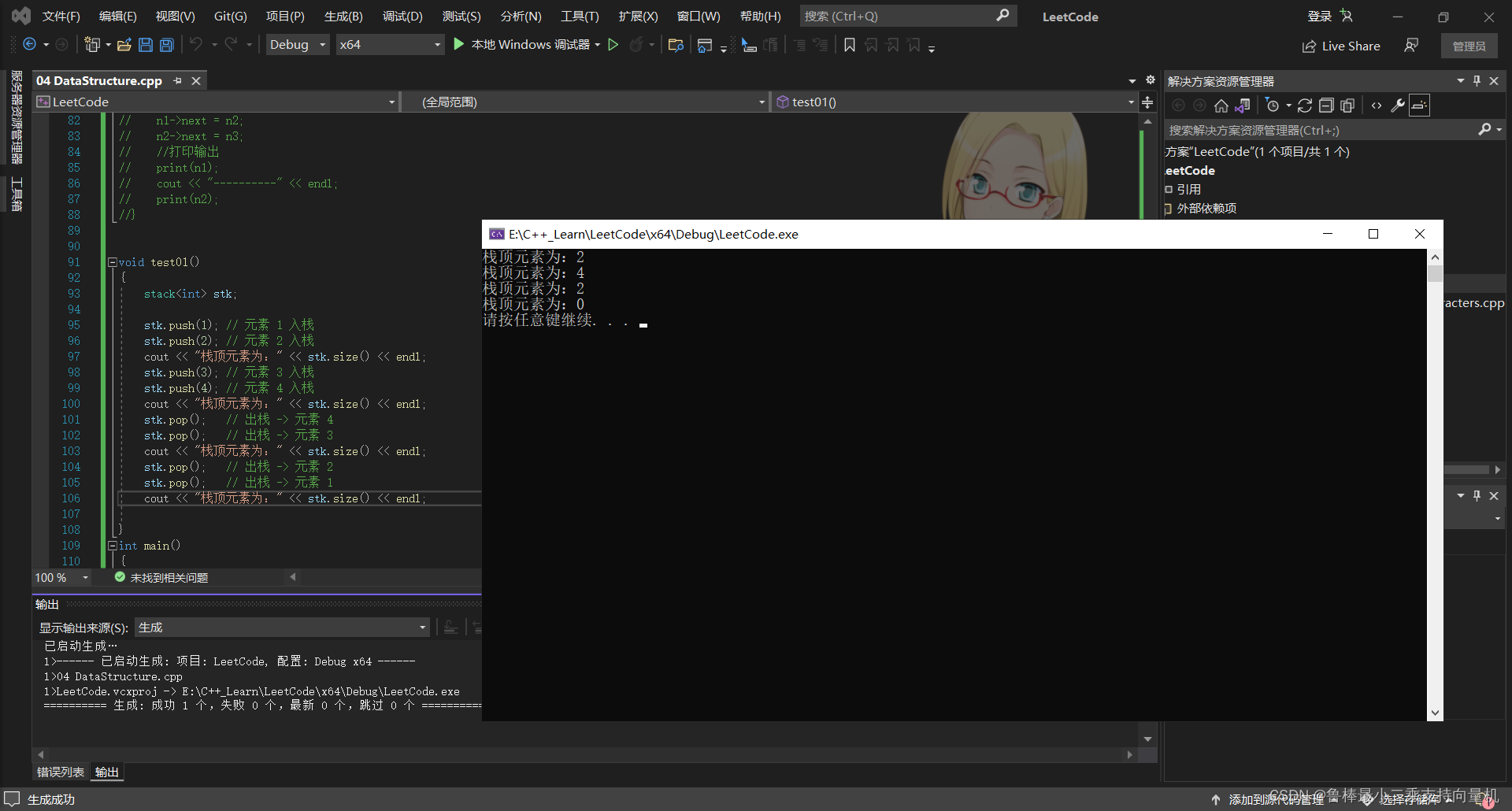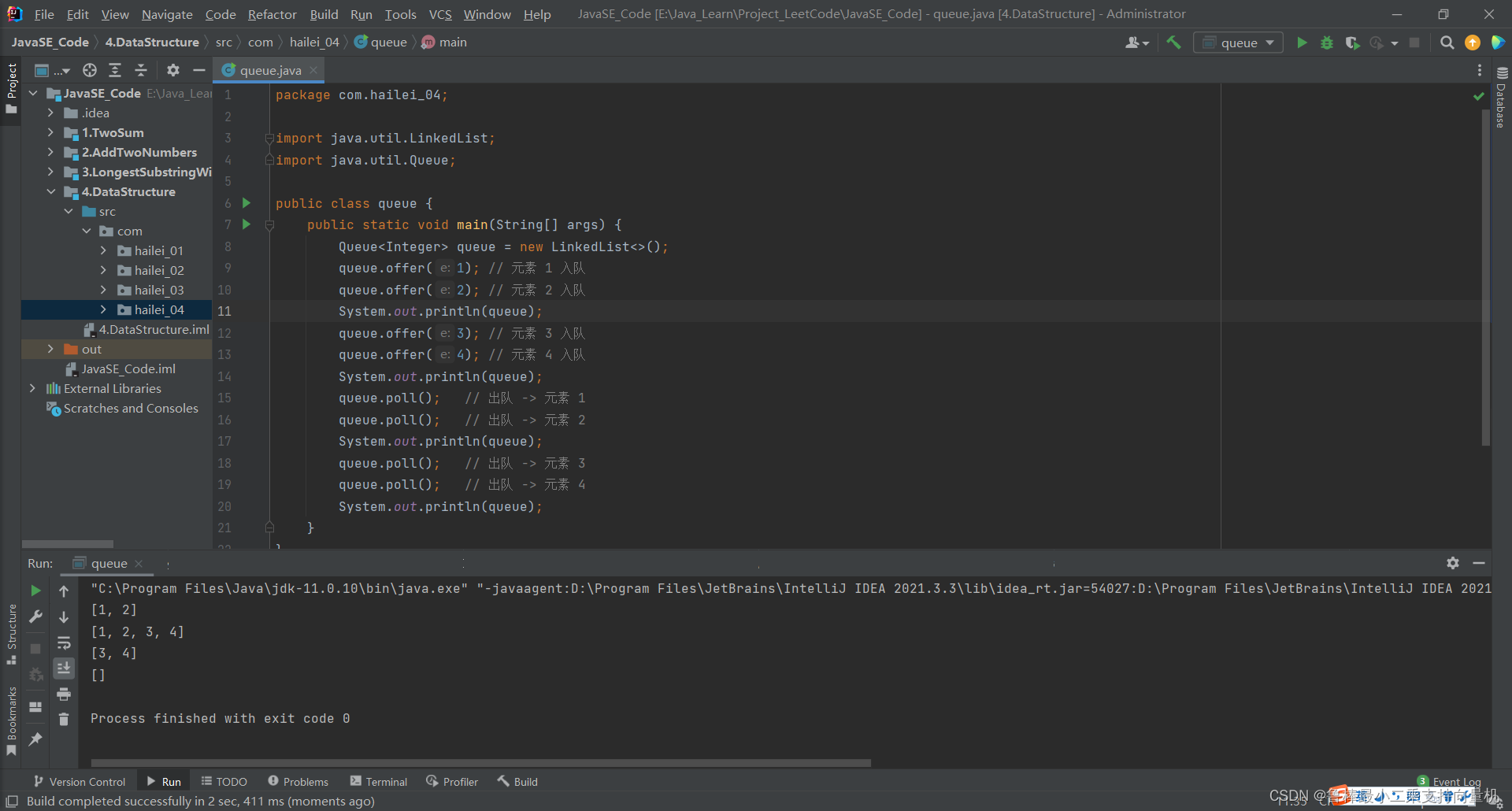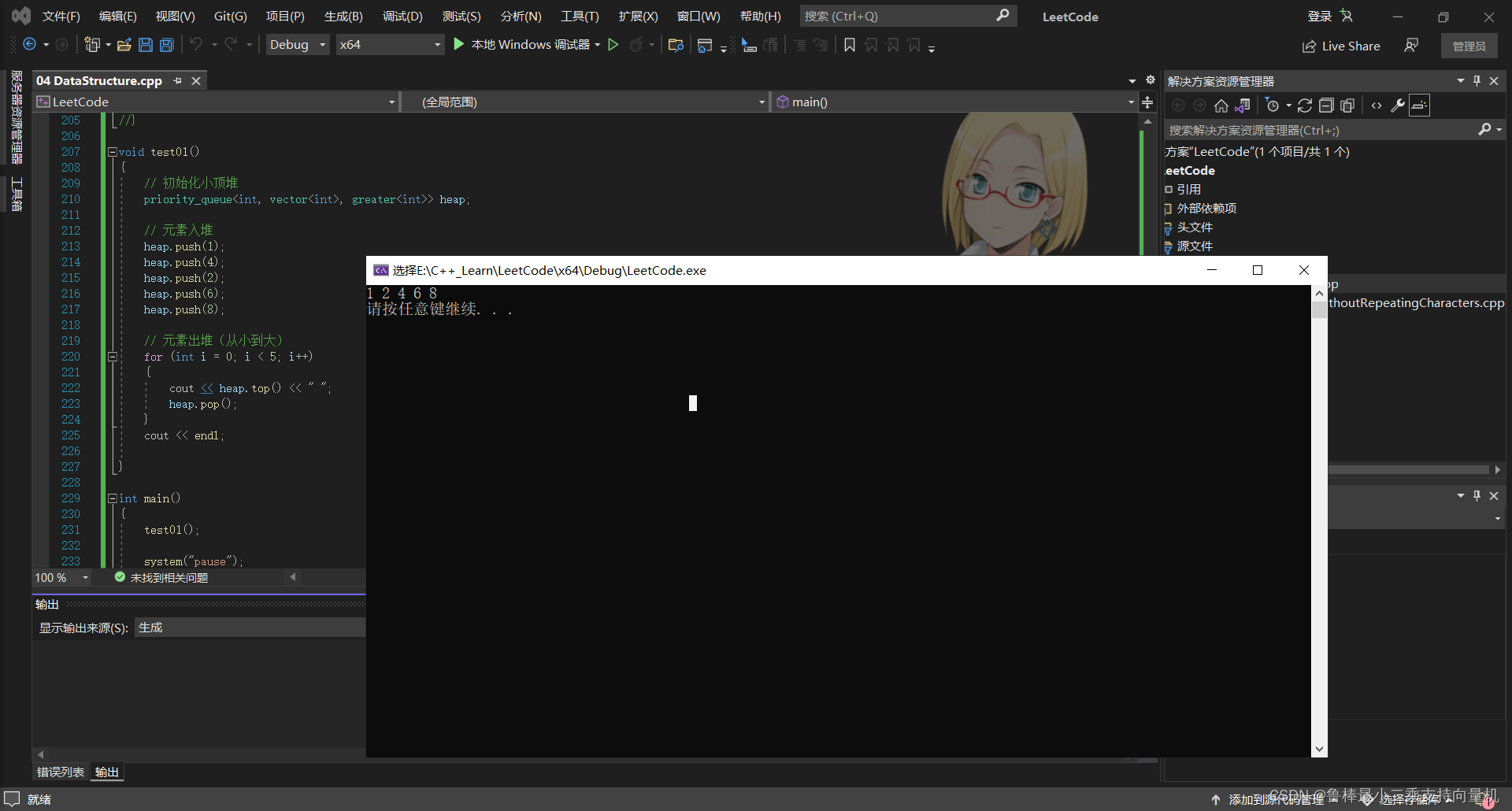4. 图解算法数据结构
数据结构是为实现对计算机数据有效使用的各种数据组织形式,服务于各类计算机操作。不同的数据结构具有各自对应的适用场景,旨在降低各种算法计算的时间与空间复杂度,达到最佳的任务执行效率。
常见的数据结构
线性数据结构 : 数组(Array);链表(Linked List);栈(Stack);队列(Queue)
非线性数据结构 : 数(Tree);堆(Heap);散列表(Hashing);图(Graph)
数组(Array)
数组是将相同类型的元素存储于连续内存空间的数据结构,其长度不可变。
C++版本
#include <iostream>
using namespace std;
#include <vector>
void printVector(vector<int>& v)
{
for (vector<int>::iterator it = v.begin(); it != v.end(); it++)
{
cout << *it << " ";
}
cout << endl;
}
template <class T>
void printArray(T& array)
{
for (int i = 0; i < sizeof(array)/sizeof(array[0]); i++)
{
cout << array[i] << " ";
}
cout << endl;
}
void test01()
{
// 初始化一个长度为 5 的数组
int array[5];
// 元素赋值
array[0] = 0;
array[1] = 1;
array[2] = 2;
array[3] = 3;
array[4] = 4;
printArray(array);
}
void test02()
{
int array[] = { 0, 1, 2, 3, 4 };
printArray(array);
}
void test03()
{
// 初始化可变数组
vector<int> array;
// 向尾部添加元素
array.push_back(0);
array.push_back(1);
array.push_back(2);
array.push_back(3);
array.push_back(4);
printVector(array);
}
int main()
{
test01();
cout << "------------------" << endl;
test02();
cout << "------------------" << endl;
test03();
system("pause");
return 0;
}

Python版本
def test01():
array = [1, 2, 3, 4, 5]
print(array)
def test02():
# 初始化可变数组
array = []
# 向尾部添加元素
array.append(1)
array.append(2)
array.append(3)
array.append(4)
array.append(5)
print(array)
# 切片
print(array[0:3])
print(array[:3])
print(array[1:4])
print(array[2:])
def test03():
array = list(range(1,6))
print(array)
arrayeven = list(range(2,6,2))
print(arrayeven)
arrayodd = list(range(1,6,2))
print(arrayodd)
if __name__=="__main__":
test01()
print("--------------")
test02()
print("--------------")
test03()

Java版本
package com.hailei_01;
import java.util.ArrayList;
import java.util.List;
public class array {
public static void main(String[] args) {
// 初始化一个长度为 5 的数组 array
int[] array1 = new int[5];
// 元素赋值
array1[0] = 1;
array1[1] = 2;
array1[2] = 3;
array1[3] = 4;
array1[4] = 5;
for(int i=0;i<array1.length;i++)
{
System.out.print(array1[i]+" ");
}
System.out.println("\n------------");
int[] array2 = {1, 2, 3, 4, 5};
for(int a:array2) //增强for
{
System.out.print(a+" ");
}
System.out.println("\n------------");
// 初始化可变数组
List<Integer> array3 = new ArrayList<>();
// 向尾部添加元素
array3.add(1);
array3.add(2);
array3.add(3);
array3.add(4);
array3.add(5);
System.out.println(array3);
}
}

链表(Linked List)
链表以节点为单位,每个元素都是一个独立对象,在内存空间的存储是非连续的。
C++版本
struct ListNode {
int val; // 节点值
ListNode* next; // 后继节点引用
ListNode(int x) : val(x), next(NULL) {}
};
void print(ListNode* phead)//输出
{
ListNode* p = phead;
while (p != NULL)
{
cout << p->val << " ";
p = p->next;
}
cout << endl;
}
void test01()
{
// 实例化节点
ListNode* n1 = new ListNode(1); // 节点 head
ListNode* n2 = new ListNode(2);
ListNode* n3 = new ListNode(3);
// 构建引用指向
n1->next = n2;
n2->next = n3;
//打印输出
print(n1);
cout << "----------" << endl;
print(n2);
}
int main()
{
test01();
system("pause");
return 0;
}

Python版本
#include <iostream>
using namespace std;
class ListNode:
def __init__(self, x):
self.val = x # 节点值
self.next = None # 后继节点引用
def print_ListNode(node):
while node:
print(node.val, end=' ')
node = node.next
def test01():
# 实例化节点
n1 = ListNode(3) # 节点 head
n2 = ListNode(2)
n3 = ListNode(1)
# 构建引用指向
n1.next = n2
n2.next = n3
print_ListNode(n1)
print("\n--------------")
print_ListNode(n2)
if __name__=="__main__":
test01()

Java版本
package com.hailei_02;
public class listNode {
public static void main(String[] args) {
// 实例化节点
ListNode n1 = new ListNode(9); // 节点 head
ListNode n2 = new ListNode(3);
ListNode n3 = new ListNode(6);
// 构建引用指向
n1.next = n2;
n2.next = n3;
printListNode(n1);
System.out.println("\n-------------");
printListNode(n3);
}
public static class ListNode {
int val; // 节点值
ListNode next; // 后继节点引用
ListNode(int x) { val = x; }
}
public static void printListNode(ListNode headNode) {
ListNode listNode = headNode;
while(listNode!=null) {
System.out.print(listNode.val+" ");
listNode = listNode.next;
}
}
}

栈(Stack)
栈是一种具有 先入后出 特点的抽象数据结构,可使用数组或链表实现。
C++版本
#include <iostream>
using namespace std;
#include <stack>
void test01()
{
stack<int> stk;
stk.push(1); // 元素 1 入栈
stk.push(2); // 元素 2 入栈
cout << "栈顶元素为:" << stk.size() << endl;
stk.push(3); // 元素 3 入栈
stk.push(4); // 元素 4 入栈
cout << "栈顶元素为:" << stk.size() << endl;
stk.pop(); // 出栈 -> 元素 4
stk.pop(); // 出栈 -> 元素 3
cout << "栈顶元素为:" << stk.size() << endl;
stk.pop(); // 出栈 -> 元素 2
stk.pop(); // 出栈 -> 元素 1
cout << "栈顶元素为:" << stk.size() << endl;
}
int main()
{
test01();
system("pause");
return 0;
}

Python版本
def test01():
stack = [] # Python 可将列表作为栈使用
stack.append(1) # 元素 1 入栈
stack.append(2) # 元素 2 入栈
print(stack)
stack.append(3) # 元素 3 入栈
stack.append(4) # 元素 4 入栈
print(stack)
stack.pop() # 出栈 -> 元素 4
stack.pop() # 出栈 -> 元素 3
print(stack)
stack.pop() # 出栈 -> 元素 2
stack.pop() # 出栈 -> 元素 1
print(stack)
if __name__=="__main__":
test01()

Java版本
package com.hailei_03;
import java.util.LinkedList;
public class stack {
public static void main(String[] args) {
LinkedList<Integer> stack = new LinkedList<>();
stack.addLast(1); // 元素 1 入栈
stack.addLast(2); // 元素 2 入栈
stack.addLast(3); // 元素 3入栈
stack.addLast(4); // 元素 4 入栈
System.out.println("第一个元素:"+stack.getFirst());
System.out.println("最后一个元素:"+stack.getLast());
stack.removeLast(); // 出栈 -> 元素 4
stack.removeLast(); // 出栈 -> 元素 3
System.out.println("第一个元素:"+stack.getFirst());
System.out.println("最后一个元素:"+stack.getLast());
stack.removeLast(); // 出栈 -> 元素 2
stack.removeLast(); // 出栈 -> 元素 1
}
}

队列(Queue)
队列是一种具有 先入先出 特点的抽象数据结构,可使用链表实现。
C++版本
#include <iostream>
using namespace std;
#include <queue>
void test01()
{
queue<int> que;
que.push(1); // 元素 1 入队
que.push(2); // 元素 2 入队
que.push(3); // 元素 3 入队
que.push(4); // 元素 4 入队
cout << "队头元素为:" << que.front() << endl;
cout << "队尾元素为:" << que.back() << endl;
que.pop(); // 出队 -> 元素 1
que.pop(); // 出队 -> 元素 2
cout << "队头元素为:" << que.front() << endl;
cout << "队尾元素为:" << que.back() << endl;
que.pop(); // 出队 -> 元素 3
que.pop(); // 出队 -> 元素 4
cout << "队列元素为:" << que.size() << endl;
}
int main()
{
test01();
system("pause");
return 0;
}

Python版本
from collections import deque
def test01():
que = deque()
que.append(1) # 元素 1 入队
que.append(2) # 元素 2 入队
que.append(3) # 元素 3 入队
que.append(4) # 元素 4 入队
print(que)
que.popleft() # 出队 -> 元素 1
que.popleft() # 出队 -> 元素 2
print(que)
que.popleft() # 出队 -> 元素 3
que.popleft() # 出队 -> 元素 4
print(que)
if __name__=="__main__":
test01()

Java版本
package com.hailei_04;
import java.util.LinkedList;
import java.util.Queue;
public class queue {
public static void main(String[] args) {
Queue<Integer> queue = new LinkedList<>();
queue.offer(1); // 元素 1 入队
queue.offer(2); // 元素 2 入队
System.out.println(queue);
queue.offer(3); // 元素 3 入队
queue.offer(4); // 元素 4 入队
System.out.println(queue);
queue.poll(); // 出队 -> 元素 1
queue.poll(); // 出队 -> 元素 2
System.out.println(queue);
queue.poll(); // 出队 -> 元素 3
queue.poll(); // 出队 -> 元素 4
System.out.println(queue);
}
}

树(Tree)
树是一种非线性数据结构,根据子节点数量可分为 二叉树 和 多叉树,最顶层的节点称为根节点 root。
二叉树,每个节点包含三个成员变量:值 val、左子节点 left、右子节点 right 。
C++版本
#include <iostream>
using namespace std;
struct TreeNode {
int val; // 节点值
TreeNode* left; // 左子节点
TreeNode* right; // 右子节点
TreeNode(int x) : val(x), left(NULL), right(NULL) {}
};
void printTree(TreeNode * tree)
{
TreeNode* n = tree;
if (n != NULL)
{
cout << n->val <<" ";
printTree(n->left);
cout << endl;
printTree(n->right);
}
}
void test01()
{
// 初始化节点
TreeNode* n1 = new TreeNode(1); // 根节点 root
TreeNode* n2 = new TreeNode(2);
TreeNode* n3 = new TreeNode(3);
TreeNode* n4 = new TreeNode(4);
TreeNode* n5 = new TreeNode(5);
// 构建引用指向
n1->left = n2;
n1->right = n3;
n2->left = n4;
n2->right = n5;
printTree(n1);
}
int main()
{
test01();
system("pause");
return 0;
}

Python版本
class TreeNode:
def __init__(self, x):
self.val = x # 节点值
self.left = None # 左子节点
self.right = None # 右子节点
def printTree(tree):
if tree:
print(tree.val,end=' ')
printTree(tree.left)
print()
printTree(tree.right)
def test01():
# 初始化节点
n1 = TreeNode(1) # 根节点 root
n2 = TreeNode(2)
n3 = TreeNode(3)
n4 = TreeNode(4)
n5 = TreeNode(5)
# 构建引用指向
n1.left = n2
n1.right = n3
n2.left = n4
n2.right = n5
printTree(n1)
if __name__=="__main__":
test01()

Java版本
package com.hailei_05;
public class tree {
public static void main(String[] args) {
// 初始化节点
TreeNode n1 = new TreeNode(1); // 根节点 root
TreeNode n2 = new TreeNode(2);
TreeNode n3 = new TreeNode(3);
TreeNode n4 = new TreeNode(4);
TreeNode n5 = new TreeNode(5);
// 构建引用指向
n1.left = n2;
n1.right = n3;
n2.left = n4;
n2.right = n5;
printTree(n1);
}
public static class TreeNode {
int val; // 节点值
TreeNode left; // 左子节点
TreeNode right; // 右子节点
TreeNode(int x) { val = x; }
}
public static void printTree(TreeNode tree)
{
TreeNode n = tree;
if (n != null)
{
System.out.print(n.val+" ");
printTree(n.left);
System.out.println();
printTree(n.right);
}
}
}

图(Graph)
图是一种非线性数据结构,由 节点(顶点)vertex 和 边 edge 组成,每条边连接一对顶点。根据边的方向有无,图可分为 有向图 和 无向图。
顶点集合: vertices = {1, 2, 3, 4, 5}
边集合: edges = {(1, 2), (1, 3), (1, 4), (1, 5), (2, 4), (3, 5), (4, 5)}
表示图的方法通常有两种:邻接矩阵和邻接表。
C++版本
#include <iostream>
using namespace std;
void test01()
{
int vertices[5] = { 1, 2, 3, 4, 5 };
int edges[5][5] = { {0, 1, 1, 1, 1},
{1, 0, 0, 1, 0},
{1, 0, 0, 0, 1},
{1, 1, 0, 0, 1},
{1, 0, 1, 1, 0} };
int count = sizeof(vertices) / sizeof(vertices[0]);
for (int i = 0;i < count; i++)
{
for (int j = 0; j < count; j++)
{
if (edges[i][j] == 0)
cout << "顶点" << i << "和顶点" << j << "不连通" << endl;
else
cout << "顶点" << i << "和顶点" << j << "连通" << endl;
}
}
}
int main()
{
test01();
system("pause");
return 0;
}

Python版本
def relationship(vertices,edges):
count = len(vertices)
adjlist = edges
for i in range(count):
for j in range(count):
if adjlist[i][j] == 0:
print("顶点{}和{}不连通".format(i,j))
else:
print("顶点{}和{}连通".format(i,j))
def test01():
vertices = [1, 2, 3, 4, 5]
edges = [[0, 1, 1, 1, 1],
[1, 0, 0, 1, 0],
[1, 0, 0, 0, 1],
[1, 1, 0, 0, 1],
[1, 0, 1, 1, 0]]
relationship(vertices,edges)
if __name__=="__main__":
test01()

Java版本
package com.hailei_06;
public class graph {
public static void main(String[] args) {
int[] vertices = {1, 2, 3, 4, 5};
int[][] edges = {{0, 1, 1, 1, 1},
{1, 0, 0, 1, 0},
{1, 0, 0, 0, 1},
{1, 1, 0, 0, 1},
{1, 0, 1, 1, 0}};
for(int i=0;i<vertices.length;i++)
{
for(int j=0;j<vertices.length;j++)
{
if (edges[i][j]==0)
System.out.println("顶点"+i+"和顶点"+j+"不连通");
else
System.out.println("顶点"+i+"和顶点"+j+"连通");
}
}
}
}

散列表(Hashing)
散列表是一种非线性数据结构,通过利用 Hash 函数将指定的键 key映射至对应的值 value,以实现高效的元素查找。
C++版本
#include <iostream>
using namespace std;
#include <unordered_map>
#include <iomanip>
void test01()
{
// 初始化散列表
unordered_map<string, int> dic;
// 添加 key -> value 键值对
dic["qwe"] = 0001;
dic["asd"] = 0002;
dic["zxc"] = 0003;
// 从姓名查找学号
cout << "qwe的学号是:" << setw(4) << setfill('0') << dic.find("qwe")->second << endl;
cout << "asd的学号是:" << setw(4) << setfill('0') << dic.find("asd")->second << endl;
cout << "zxc的学号是:" << setw(4) << setfill('0') << dic.find("zxc")->second << endl;
}
int main()
{
test01();
system("pause");
return 0;
}

Python版本
def test01():
# 初始化散列表
dic = {}
# 添加 key -> value 键值对
dic["qwe"] = 10001
dic["asd"] = 10002
dic["zxc"] = 10003
# 从姓名查找学号
print("qwe的学号是:{}".format(dic["qwe"]))
print("asd的学号是:{}".format(dic["asd"]))
print("zxc的学号是:{}".format(dic["zxc"]))
if __name__=="__main__":
test01()

Java版本
package com.hailei_07;
import java.util.HashMap;
import java.util.Map;
public class hashing {
public static void main(String[] args) {
// 初始化散列表
Map<String, Integer> dic = new HashMap<>();
// 添加 key -> value 键值对
dic.put("asd", 0001);
dic.put("qwe", 0002);
dic.put("zxc", 0003);
// 从姓名查找学号
System.out.println("qwe的学号是:" + String.format("%04d",dic.get("qwe")));
System.out.println("asd的学号是:" + String.format("%04d",dic.get("asd")));
System.out.println("zxc的学号是:" + String.format("%04d",dic.get("zxc")));
}
}

堆(Heap)
堆是一种基于完全二叉树的数据结构,可使用数组实现。以堆为原理的排序算法称为堆排序,基于堆实现的数据结构为优先队列。堆分为大顶堆和小顶堆,大(小)顶堆:任意节点的值不大于(小于)其父节点的值。
完全二叉树定义: 设二叉树深度为 k ,若二叉树除第 kk层外的其它各层(第 1 至 k-1 层)的节点达到最大个数,且处于第 k 层的节点都连续集中在最左边,则称此二叉树为完全二叉树。
C++版本
#include <iostream>
using namespace std;
#include <vector>
void test01()
{
// 初始化小顶堆
priority_queue<int, vector<int>, greater<int>> heap;
// 元素入堆
heap.push(1);
heap.push(4);
heap.push(2);
heap.push(6);
heap.push(8);
// 元素出堆(从小到大)
for (int i = 0; i < 5; i++)
{
cout << heap.top() << " ";
heap.pop();
}
cout << endl;
}
int main()
{
test01();
system("pause");
return 0;
}

Python版本
from heapq import heappush, heappop
def test01():
# 初始化小顶堆
heap = []
# 元素入堆
heappush(heap, 1)
heappush(heap, 4)
heappush(heap, 2)
heappush(heap, 6)
heappush(heap, 8)
print(heap)
heappop(heap)
print(heap)
heappop(heap)
print(heap)
heappop(heap)
print(heap)
heappop(heap)
print(heap)
heappop(heap)
print(heap)
if __name__=="__main__":
test01()

Java版本
package com.hailei_08;
import java.util.PriorityQueue;
import java.util.Queue;
public class heap {
public static void main(String[] args) {
// 初始化小顶堆
Queue<Integer> heap = new PriorityQueue<>();
// 元素入堆
heap.add(1);
heap.add(4);
heap.add(2);
heap.add(6);
heap.add(8);
// 元素出堆(从小到大)
System.out.println(heap);
heap.poll(); // -> 1
System.out.println(heap);
heap.poll(); // -> 2
System.out.println(heap);
heap.poll(); // -> 4
System.out.println(heap);
heap.poll(); // -> 6
System.out.println(heap);
heap.poll(); // -> 8
System.out.println(heap);
}
}

希望本文对大家有帮助,上文若有不妥之处,欢迎指正
分享决定高度,学习拉开差距
























 192
192











 被折叠的 条评论
为什么被折叠?
被折叠的 条评论
为什么被折叠?










